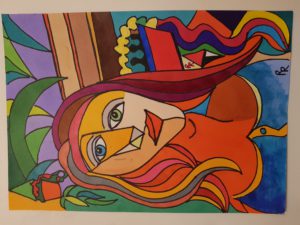Judgement In Art…
I’m reading a book at the moment about the relationship between Matisse and Picasso. It charts their rivalry, their friendship and how both dimensions shaped their art.
One of the things that strikes me in the reading is the level they were working at. That their ideas and philosophies were actively moulding what art would become. Even their vagaries and whims had seismic effects.
But they had to weather some reactions that would destroy many of us. Disbelief, hilarity, ridicule and even disgust. Matisse actually had to prevent his wife from viewing her portrait because of the things people were saying about it.
And, being truthful, I didn’t like their work when I was younger. I gave in to the populist response ‘my five-year old could do that’. I was locked into a hyper realist world where only absolute representation would do. As a young artist I hid behind detail, behind absolute replication, terrified of self-expression and criticism.
But that was partly due to my ignorance, to a system of under or miseducation. I was sadly unaware of what these artists were working towards, what they were hoping to achieve. Like blending figures into landscapes, eradicating solid lines, allowing the energy of subject and setting to bleed back and forth. They were chasing something transcendental.
I was stunned by this.
And so, I’ve learned – belatedly – several things. First, that education is often a
personal journey, driven by interest and aptitude. Our education systems program and mould but they rarely enlighten and challenge us. In fact, I would say that Bowles and Gintis were right, and the discipline of education is more important than its content. This means that we need to redefine education as life-long and self-directed.
Second, that I need to look deeper, to reach beneath the surface of things. The tendency to dismiss and ridicule is also a systemic thing. The cultures we are raised in are limiting, distorting, they prevent our thought from rising, from reaching. The desire is to maintain, constrain and repress. We can see further if we choose.
And finally, that Whistler was right, certainly about how to judge art. He enjoined us to say not that a piece of art was bad, but rather that we don’t like it. This reflects that art is subjective and that what we may like others won’t and vice versa. But more than this, I see it as an injunction against that pettiness and spite that informs so much criticism. This is about more than art, it is about life, or, perhaps it is the recognition that art is life and that an open heart and an open mind are healthier vehicles to drive than their opposites…
Radical Rhymes is a professional artist working with a range of media – predominantly animal/human portraits and landscapes – including, most recently, hand painted furniture. You can see his work on Instagram Radicalrhymes1969 or on Twitter @RhymesRadical.
For commissions, please contact him on Twitter via Direct Message or by email at: radicalrhymes@outlook.com His work is also available to buy on Etsy
[si-contact-form form=’2′]


